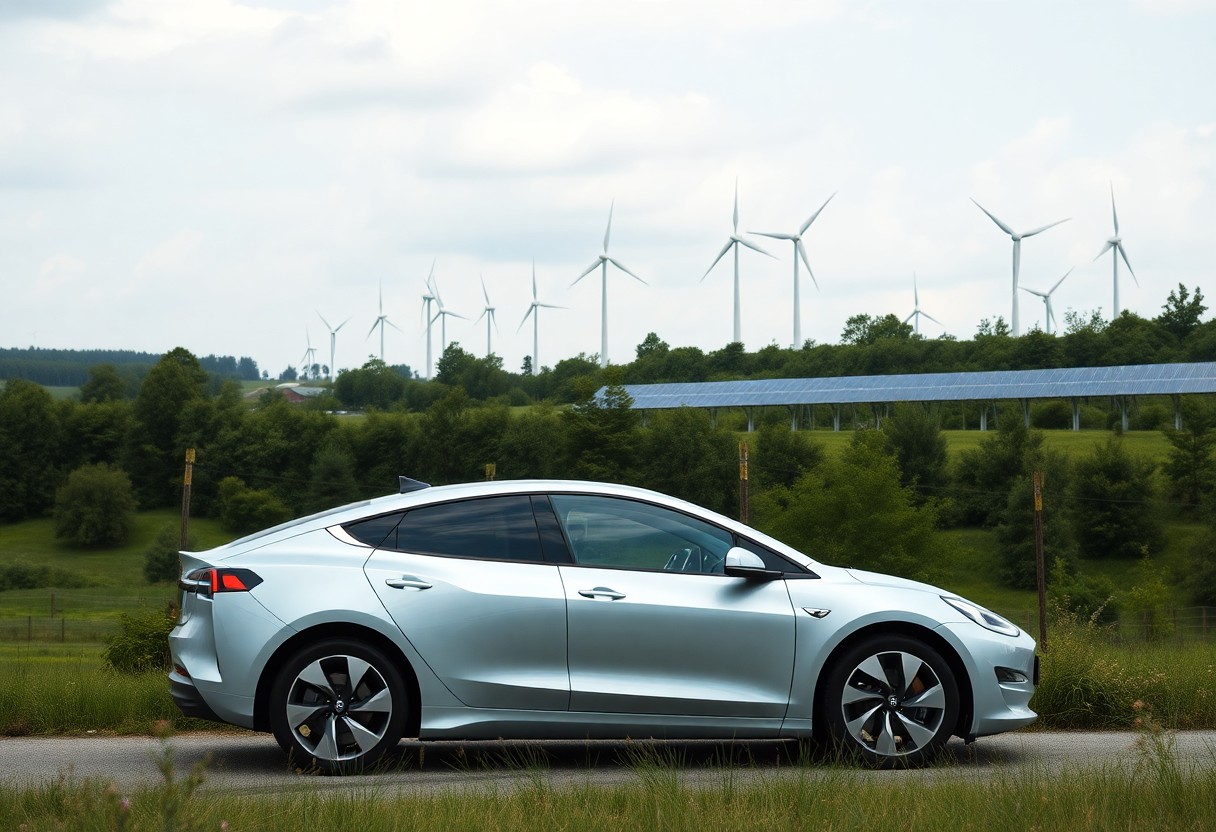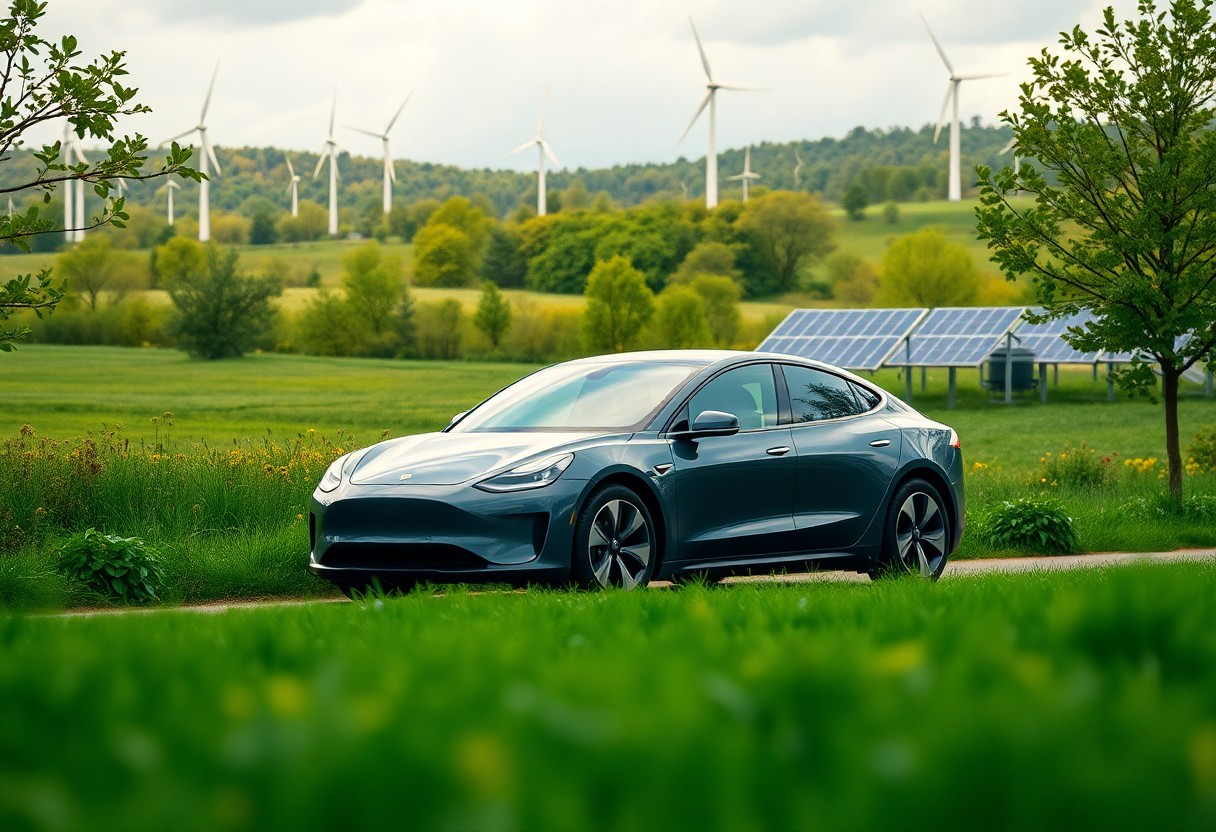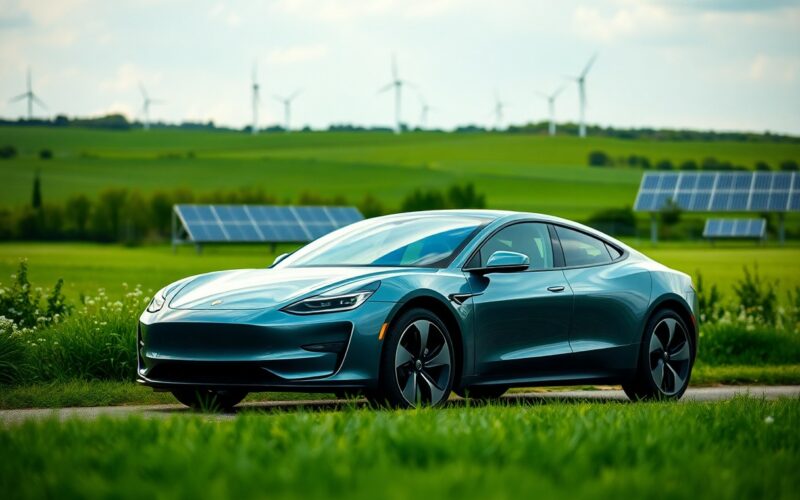It’s necessary for you to understand the transformative impact of electric vehicles (EVs) on our journey towards carbon neutrality. As traditional transportation methods heavily contribute to greenhouse gas emissions, switching to EVs can significantly reduce your carbon footprint. You hold the power to make a difference by opting for cleaner alternatives, thereby promoting sustainable practices. In this post, we will explore how EVs not only help in decreasing harmful emissions but also positively influence energy consumption, paving the way for a more environmentally friendly future.
Table of Contents
Key Takeaways:
- Electric vehicles (EVs) are imperative in reducing greenhouse gas emissions, as they produce zero tailpipe emissions compared to traditional gasoline vehicles.
- Widespread adoption of EVs contributes to a decrease in reliance on fossil fuels, promoting energy independence and sustainability.
- The integration of renewable energy sources, like solar and wind, with charging infrastructure enhances the environmental benefits of electric vehicles.
- Government incentives and support for EV infrastructure development play a significant role in accelerating the transition to electric mobility.
- Advancements in battery technology can increase the efficiency and range of EVs, making them an increasingly viable option for a wider range of consumers.
Understanding Carbon Neutrality
While navigating the complexities of climate change, it becomes vital to grasp the concept of carbon neutrality. Carbon neutrality means balancing the amount of carbon dioxide emitted with an equivalent amount of carbon dioxide removed from the atmosphere. This balance can be achieved through various means, such as reducing emissions, enhancing energy efficiency, and investing in renewable energy sources or carbon offset projects. If you’re interested in delving deeper, check out The Role of Electric Vehicles (EVs) in Achieving Net Zero.
Definition of Carbon Neutrality
Between the growing concerns about climate change and the pressing need for sustainable practices, understanding carbon neutrality has never been more important. Essentially, it involves neutralizing your carbon footprint by either minimizing emissions through sustainable practices or investing in projects that contribute to carbon offsetting. You can think of it as a commitment to achieving a net-zero carbon footprint, which involves a blend of personal actions and wider community initiatives.
Historical Context and Importance
Against the backdrop of industrialization and urban growth, human activities have overwhelmingly contributed to the increase in greenhouse gas emissions, particularly CO2. As you explore the historical context of carbon emissions, you will find that the post-industrial era has marked a historical shift in energy consumption patterns, leading to a noticeable degradation of earth’s climate. The urgent need for carbon neutrality is highlighted by the stark consequences of climate change, which can impact everything from your local weather to global food security.
Considering this historical trajectory, understanding carbon neutrality is paramount for policymaking and individual action. The increasing frequency of climate-related disasters serves as a call to action. Individuals, businesses, and governments are now realizing their part in contributing to a solution. By grasping the significance of carbon neutrality, you can empower yourself to make informed decisions that reduce your carbon footprint, whether at home or in your community.
Global Goals and Agreements
Carbon emissions do not respect borders, and the fight against climate change necessitates a global response. International treaties, such as the Paris Agreement, are designed to limit global warming to well below 2 degrees Celsius, aiming for 1.5 degrees as a target. As you consider the implications of these global agreements, you recognize that achieving carbon neutrality is not only beneficial but vital for the health of our planet and future generations. The collaborative efforts of nations around the globe highlight a shared commitment to sustainable practices and an entirely reinvented energy landscape.
Also, as countries strive to meet their commitments under international agreements, this collective endeavor amplifies the pressing need for innovation in green technologies. From renewable energy to electric vehicles, these advancements pave the way toward reducing emissions effectively. By supporting these changes, you contribute to a larger movement aimed at fostering sustainability and a cleaner environment.

Overview of Electric Vehicles (EVs)
There’s no denying that electric vehicles (EVs) play a significant role in reshaping the automotive landscape. As you consider your options for transportation that aligns with a carbon-neutral future, it’s imperative to understand the various types of EVs available today. Electric vehicles utilize electricity as a primary source of power, offering a cleaner alternative to traditional gasoline-powered cars. As an informed consumer, you will find that choosing an EV can not only benefit the environment but may also offer you savings in fuel and maintenance costs.
Types of Electric Vehicles
The landscape of electric vehicles is diverse, catering to different needs and preferences. The following table outlines the primary types of EVs:
| Type of EV | Description |
| Battery Electric Vehicles (BEVs) | Powered solely by electricity, with no internal combustion engine (ICE). |
| Plug-in Hybrid Electric Vehicles (PHEVs) | Combine a conventional engine with an electric motor that can be recharged. |
| Hybrid Electric Vehicles (HEVs) | Use both an electric motor and an engine for improved fuel efficiency. |
| Fuel Cell Electric Vehicles (FCEVs) | Generate electricity through a chemical process using hydrogen. |
| Extended Range Electric Vehicles (EREVs) | Primarily electricity-powered but includes a small ICE to extend range. |
This array of options ensures you can find an EV that fits your lifestyle and preferences while contributing to lower emissions.
Evolution of EV Technology
The evolution of electric vehicle technology has dramatically advanced over the past decades. Initially perceived as impractical, EVs have seen incredible developments in battery efficiency, charging infrastructure, and overall performance. Modern Battery Electric Vehicles (BEVs) can now travel longer distances on a single charge, giving them parity with traditional ICE vehicles. As technology improves, manufacturing costs have also decreased, making electric vehicles more accessible to a broader audience.
The increased investment in research and development has led to significant improvements in range and battery life, thus enhancing the reliability and convenience of owning an EV. These advancements are paving the way for wider adoption, making electric vehicles a viable and attractive option for consumers.
Even as you investigate deeper into this topic, it becomes clear that the technological enhancements in EVs are pivotal in promoting a sustainable future. The reduction in manufacturing costs and improvements in battery technology have contributed to this trend, allowing more consumers to consider making the switch to clean energy vehicles.
Comparison with Conventional Vehicles
An important aspect to consider when evaluating your transportation options is how electric vehicles stack up against conventional vehicles. The following table highlights key differences between EVs and gasoline-powered cars:
| Aspect | Electric Vehicles | Conventional Vehicles |
| Emissions | Zero tailpipe emissions | Produces greenhouse gases |
| Fuel Cost | Lower electricity costs | Higher gasoline prices |
| Maintenance | Lower maintenance costs | Regular engine maintenance required |
| Performance | Instant torque and responsiveness | May lag in acceleration |
| Operation | Quiet operation | Noise and vibrations from the engine |
Understanding these differences can help you make a more informed decision about your vehicle choice, taking into consideration aspects like emissions, cost, and overall performance.
Vehicles such as electric cars can significantly reduce your carbon footprint compared to traditional gasoline-powered options, offering both environmental benefits and economic advantages over time. With the growing commitment towards sustainability and innovative technologies, you are in a position to choose an option that aligns with your values while contributing positively to the planet.

Environmental Impact of Electric Vehicles
Unlike traditional vehicles that run on fossil fuels, electric vehicles (EVs) offer a more sustainable mode of transportation. By harnessing electricity, particularly from renewable energy sources, you have the potential to significantly reduce your carbon footprint. This shift not only aids in combating climate change but also plays a key role in achieving broader environmental objectives, including carbon neutrality. Understanding the multifaceted impacts of EVs can empower you to make informed choices for your mobility needs while considering the health of our planet.
Reduction of Greenhouse Gas Emissions
About 70% of greenhouse gas emissions in the transportation sector can stem from gasoline and diesel vehicles. When you opt for an electric vehicle, you are contributing to a significant decrease in these emissions. Even when accounting for the electricity source used to charge the vehicle, studies show that EVs often produce fewer greenhouse gases over their lifetime than their internal combustion engine counterparts. This shift can lead to a marked improvement in climate stability and plays a vital role in efforts to achieve carbon neutrality.
Moreover, as the energy grid continues to incorporate more renewable energy sources, the carbon benefits of driving an electric vehicle are expected to grow. Your decision to switch to an EV helps accelerate the demand for cleaner energy and encourages broader adoption of sustainable practices across the industry.
Life Cycle Analysis of EVs
Electric vehicles, while often perceived as cleaner alternatives, require thorough analysis through their entire life cycle to better understand their environmental impact. Electric vehicles are generally more efficient in terms of energy use compared to traditional vehicles, but the production and disposal phases can have notable implications. For instance, lithium-ion batteries, vital for EV operation, involve mining and resource extraction that can be environmentally taxing. Electric vehicles can achieve a lower overall environmental footprint over their lifetime when you factor in their operational efficiencies and the growing focus on sustainable battery recycling processes.
Considering the life cycle of electric vehicles means recognizing both the benefits and downsides associated with their production and usage. It encourages ongoing innovation in battery technology, sustainable sourcing of materials, and increased pressure on manufacturers to adopt eco-friendly practices. Your awareness can drive demand for advancements that maintain the integrity of environmental goals.
Effects on Air Quality
Below the surface, one of the most significant benefits of electric vehicles is their potential to improve urban air quality. Because they emit zero tailpipe pollutants, EVs contribute to a decrease in harmful substances such as nitrogen oxides, particulate matter, and volatile organic compounds. This can lead to healthier environments, particularly in densely populated areas where vehicle emissions are prevalent. If you live in regions plagued by smog and poor air quality, transitioning to an EV can be a step toward cleaner air.
Furthermore, the cumulative reduction of vehicle-related pollutants through widespread EV adoption can result in significant public health improvements. By driving an electric vehicle, you are not only reducing your own personal emissions but also helping create a more sustainable and healthier atmosphere for everyone in your community.
Understanding the effects of electric vehicles on air quality underscores the positive implications of your transition. It’s an opportunity to play an active role in fostering cleaner, healthier urban spaces and to inspire others within your community to consider sustainable options for their transportation needs.

Challenges to Widespread EV Adoption
Many factors hinder the transition to electric vehicles (EVs), making it important to recognize the challenges that need addressing for a successful shift toward carbon neutrality. Among these challenges, infrastructure requirements stand out as a significant barrier to widespread EV adoption.
Infrastructure Requirements
Against the backdrop of increasing demand for EVs, the lack of adequate charging infrastructure presents a formidable hurdle. Without a comprehensive network of charging stations, potential EV owners may feel hesitant to switch from traditional vehicles. You might find that the available charging options are limited in your area, which can create anxiety about range and accessibility. Expanding charging infrastructure, especially in urban areas and remote locations, is important for easing these worries and promoting a smoother transition to electric mobility.
Additionally, you should consider the need for faster charging solutions to make EVs more appealing. Current charging stations often require longer periods to fully recharge a vehicle compared to filling up a gasoline tank. Therefore, investing in technologies that enable faster charging times is important for improving the convenience and efficiency of electric vehicle usage, ultimately encouraging more drivers to make the switch.
Battery Production and Sustainability
To accelerate electric vehicle adoption, manufacturers must also confront the challenges of battery production and sustainability. While the benefits of EVs are undeniable, the environmental impact of lithium-ion battery production cannot be overlooked. As a potential EV owner, you may be concerned about the extraction of raw materials required for manufacturing these batteries, which can lead to significant ecological damage and carbon emissions. Addressing these issues is vital for ensuring that the very solutions designed to tackle climate change do not inadvertently contribute to further environmental degradation.
Understanding the full lifecycle of EV batteries can also inform your decision-making process. For instance, recycling and reusing battery materials not only can reduce environmental harm but also support a circular economy. As manufacturers innovate in battery technology and sustainable practices, you will need to stay informed about developments that may shape the landscape of EV ownership and its long-term sustainability.
Public Perception and Acceptance
The role of public perception and acceptance in the transition to electric vehicles should not be underestimated. Many potential buyers may harbor doubts about the reliability and practicality of EVs, stemming from misconceptions regarding battery life, performance, and charging times. As you consider making the switch, it is important to challenge these perceptions with accurate information to foster a more positive attitude toward electric vehicles. The apprehension surrounding the dependence on technology and the fear of being left without sufficient charging options can significantly impact the likelihood of adoption.
A positive shift in public perception can also be influenced through targeted initiatives and education about the long-term benefits of EV ownership. Emphasizing how electric vehicles contribute to reducing carbon emissions and promoting energy independence can inspire increased acceptance. Through collective efforts to inform and educate, the transition to electric mobility stands a better chance of being embraced by the masses.
Policy and Incentives for Electric Vehicles
Once again, the focus on electric vehicles (EVs) emphasizes their critical function in the quest for a sustainable future. As governments around the globe set ambitious targets for carbon neutrality, policies and incentives play a significant role in facilitating the widespread adoption of EVs. You can explore the role of electric vehicles in achieving net zero to gain deeper insights into how these initiatives are shaping our transportation landscape.
Government Initiatives
Any effective strategy for increasing EV adoption must include robust government initiatives. Countries are implementing a variety of regulations and targets designed to shift consumers toward electric vehicles. For instance, some nations have set deadlines to ban the sale of new gasoline and diesel cars, while others offer grants and rebates for individuals who choose to purchase electric vehicles. These initiatives are designed not only to reduce emissions but also to promote technological advancements in the EV sector.
Moreover, government-led campaigns to educate the public on the environmental benefits of EVs significantly influence consumer behavior. By partnering with various stakeholders, including manufacturers and energy providers, governments can create comprehensive programs that make electric vehicles more accessible and appealing to you as a consumer. Such collaborative efforts can lead to innovative solutions that further facilitate the transition to cleaner transportation.
Financial Incentives and Subsidies
Government efforts to promote electric vehicles are complemented by various financial incentives and subsidies. Many jurisdictions provide tax credits for your EV purchases, reduced registration fees, and other financial perks that make ownership more affordable. This financial support is crucial in driving demand, particularly in cases where the upfront cost of electric vehicles may seem prohibitive.
It is crucial to note that these incentives are not just limited to buyers. Manufacturers also benefit from programs that encourage the development of charging infrastructure and technological improvements. This holistic approach ensures that both consumers and producers are motivated to embrace electric vehicles, thereby enhancing your options and contributing to the overall success of the transition to cleaner energy sources.
Regulatory Frameworks and Challenges
After discussing the various incentives, it’s important to recognize the regulatory frameworks and challenges that come into play. Different countries have established guidelines for EV production and sales, but the complexity of these regulations can sometimes lead to confusion for both consumers and manufacturers. You might find it challenging to navigate these varying regulations, especially when considering cross-border vehicle sales and charging standards.
With the rapid evolution of the electric vehicle market, regulators must adapt to new technologies and consumer needs. This constant change can lead to uncertainty in investment decisions, affecting the availability of electric vehicles in your region. Policymakers must prioritize frameworks that not only encourage adoption but also foster innovation in the EV sector. You can keep abreast of these developments to better understand how they might impact your choices in electric mobility.
The Future of Electric Vehicles in Carbon Neutrality
After exploring the immediate impacts of electric vehicles (EVs) on carbon neutrality, it’s necessary to look ahead at how future developments can further enhance their role. The landscape of transportation is evolving rapidly, and with it, the potential for EVs to contribute to a greener planet is growing. As advancements in technology and policy come together, you can expect to see a more robust integration of electric vehicles into daily life, aiming to reduce emissions significantly.
Innovations in EV Technology
To fully understand the future, you need to consider the ongoing innovations in EV technology. Battery efficiency is a primary focus area, with research aiming to extend range and reduce charging times significantly. Innovations like solid-state batteries promise to deliver higher energy density and lower risk of fire hazards compared to traditional lithium-ion batteries. As these technological hurdles are overcome, you will find it easier to embrace EVs without the lingering concerns related to range and recharge durations.
Moreover, advancements in autonomous driving technology complement the EV revolution. In the coming years, you might see widespread adoption of self-driving electric cars, which could optimize traffic flow and reduce unnecessary emissions stemming from congestion and inefficient driving behavior. By integrating artificial intelligence with EV systems, manufacturers will provide you with a more sustainable transport solution that is not only environmentally friendly but also adept at enhancing travel safety.
Integration with Renewable Energy Sources
Around the world, the push for carbon neutrality is driving the need for seamless integration of electric vehicles with renewable energy sources. You will likely see a future where EV charging stations are commonly powered by solar panels or wind farms, allowing you to charge your vehicle without further adding to your carbon footprint. This integration not only enhances the overall sustainability of electric vehicles but also acts as an encouragement for further investments in renewable energy infrastructure.
Further, this symbiotic relationship can lead to a multi-faceted energy ecosystem. When solar energy generation peaks during sunny days, you will have the opportunity to charge your EVs, which can also serve as a buffer to store this energy. Together, this helps balance energy demands and provides a greener option for your transportation needs.
Case Studies of Successful EV Programs
Below are notable case studies and data that highlight successful electric vehicle programs—offering real-world examples of how EVs are contributing to carbon neutrality:
- Norway: Near 60% of all new car sales in 2020 were electric, significantly lowering overall emissions.
- California: By 2022, over 1.5 million electric vehicles were registered, leading to a reduction of over 1.4 million tons of CO2 emissions.
- China: The largest market for electric vehicles, contributing to the sale of over 1.3 million EVs in 2020 alone, promoting broader EV adoption to tackle urban pollution.
- Germany: Plans for 1 million charging stations by 2030 aim to power 7-10 million electric vehicles, paving the way for significant emissions reductions.
Understanding these case studies not only showcases the significant impact of electric vehicles but also underscores the importance of collective action. By drawing on these successful programs, you can see how government policies, infrastructure investments, and innovative technologies can foster environments conducive to the growth of electric vehicles. With ongoing support from both consumers and policymakers, transitioning to a sustainable transportation future can become a reality.
Final Words
The transition to electric vehicles (EVs) represents a significant step toward achieving carbon neutrality, and your role in this journey can be transformative. By choosing to drive electric, you are not only reducing your carbon footprint but also encouraging further advancements in sustainable technologies and infrastructure. The widespread adoption of EVs has the potential to lower greenhouse gas emissions from transportation, a major contributor to climate change, and supports the shift towards renewable energy sources in the grid, ultimately enhancing the health of our planet for future generations.
As you consider the impact of your transportation choices, embracing electric vehicles can also influence policy and market trends, encouraging manufacturers to innovate and governments to invest in cleaner, more efficient systems. Your commitment to EVs can drive the collective movement toward a more sustainable future, proving that individual actions can lead to significant change. By integrating electric vehicles into your daily life, you not only contribute to carbon neutrality but also pave the way for a greener, healthier environment for all.
FAQ
Q: How do electric vehicles (EVs) contribute to carbon neutrality?
A: Electric vehicles produce no tailpipe emissions, which significantly lowers greenhouse gas emissions compared to conventional gasoline or diesel vehicles. When charged using renewable energy sources, EVs can effectively minimize carbon footprints, making them a pivotal part of initiatives aimed at achieving carbon neutrality.
Q: What is the lifecycle impact of electric vehicles on carbon emissions?
A: The lifecycle emissions of an electric vehicle include manufacturing, operation, and disposal. While manufacturing EVs, especially their batteries, can generate more emissions initially, the overall emissions during the vehicle’s operational life are generally lower compared to traditional vehicles, particularly when charged with clean energy. Eventually, using EVs helps in reducing total carbon emissions over time.
Q: How does battery production affect the environmental goals associated with electric vehicles?
A: Battery production for EVs can have significant environmental impacts, particularly due to the extraction and processing of raw materials like lithium, cobalt, and nickel. However, advancements in recycling technologies and the development of more sustainable battery materials are being explored to reduce these impacts and align battery production with environmental goals.
Q: What role does charging infrastructure play in the adoption of electric vehicles?
A: Reliable and widespread charging infrastructure is necessary for the adoption of electric vehicles. It enables consumers to charge their vehicles conveniently, reducing range anxiety. Adequate charging stations, particularly those powered by renewable energy sources, enhance the environmental benefits of EVs and help integrate them into the broader energy system.
Q: How can government policies support the transition to electric vehicles?
A: Governments can implement various policies to promote electric vehicle adoption, including financial incentives (such as tax credits or rebates), investments in charging infrastructure, stricter emissions regulations, and promoting research and development in clean technologies. These measures can create a more favorable environment for both consumers and manufacturers.
Q: Are electric vehicles suitable for all types of transportation needs?
A: While electric vehicles are ideal for many transportation needs, particularly in urban settings, they may not yet serve every segment effectively. For long-haul transport or heavy-duty applications, advancements in battery technology and alternative fuels are actively being researched to provide suitable options while working towards carbon neutrality.
Q: What is the expected future impact of electric vehicles on overall carbon emissions?
A: As electric vehicle technology advances and becomes more widespread, combined with a shift towards renewable energy sources for electricity generation, the potential to significantly reduce carbon emissions from the transportation sector increases. This transition is fundamental to global efforts in reaching carbon neutrality targets and addressing climate change challenges.

Our contributing author is a passionate advocate for eco-friendly living and sustainability. With a background in eco-life, they are dedicated to inspiring and empowering individuals to adopt environmentally conscious lifestyles. Through insightful articles, they share practical tips, innovative solutions, and thought-provoking perspectives to promote a greener, more sustainable world. Join them on the journey towards eco-smart living and discover how small choices can make a big impact. 🌱









